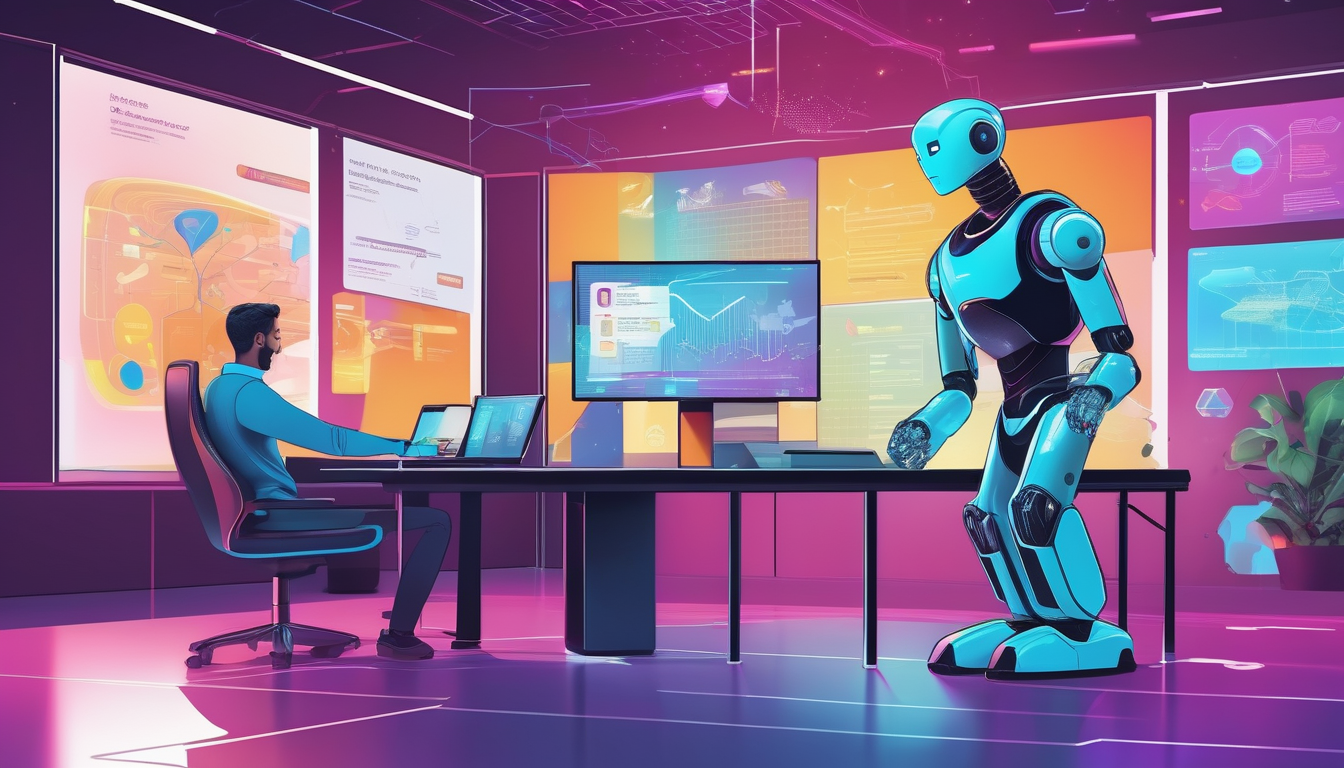How AI-Powered Chatbots Are Transforming Customer Service

In today’s fast-paced world, customer service is evolving at lightning speed, and at the forefront of this transformation are AI-powered chatbots. These digital assistants have become essential tools for businesses aiming to enhance their customer interactions. Imagine having a friendly helper available 24/7, ready to answer questions and solve problems instantly—that’s the magic of AI chatbots!
The rise of AI chatbots can be attributed to several factors. Firstly, advancements in artificial intelligence and machine learning have made it possible for these bots to understand and respond to customer inquiries more efficiently than ever before. As businesses across various industries recognize the benefits of implementing chatbots, their adoption has skyrocketed. It’s like watching a wave of innovation sweep through customer service!
One of the most significant benefits of AI chatbots is their ability to provide instant responses. Customers no longer have to wait on hold or navigate through endless phone menus. Instead, they can receive immediate assistance, enhancing their overall experience. This not only boosts customer satisfaction but also allows businesses to operate more efficiently. Imagine a world where your questions are answered in real-time, with no delays—this is the reality AI chatbots are creating.
Moreover, AI chatbots contribute to cost efficiency for businesses. By automating routine inquiries, companies can significantly reduce their operational costs. For example, consider the following table that illustrates the cost savings associated with implementing chatbots:
| Cost Factor | Traditional Customer Service | With AI Chatbots |
|---|---|---|
| Staffing Costs | High | Low |
| Response Time | Minutes | Seconds |
| Customer Satisfaction | Moderate | High |
Additionally, the scalability of AI chatbots allows businesses to handle a growing volume of inquiries without needing to hire more staff. This is particularly beneficial during peak seasons when customer demand surges. Just think about it—no more scrambling to find extra help when your business is booming!
In conclusion, AI-powered chatbots are not just a trend; they are a crucial component of modern customer service. As they continue to evolve, they promise to enhance customer experiences while providing valuable benefits to businesses. So, are you ready to embrace this exciting technological shift?

The Rise of AI Chatbots
In recent years, AI chatbots have emerged as a game changer in the realm of customer service. Their journey began with simple scripted responses, but with the rapid advancements in artificial intelligence and machine learning, these chatbots have evolved into sophisticated tools capable of understanding and responding to customer inquiries in real-time. What sparked this transformation? Well, the need for businesses to enhance customer engagement while keeping operational costs in check played a significant role.
As technology has progressed, several factors have contributed to the widespread adoption of AI chatbots across industries:
- Advancements in Natural Language Processing (NLP): This technology allows chatbots to comprehend and process human language more effectively, making interactions feel more natural.
- Increased Consumer Expectations: Customers today demand instant responses and round-the-clock service, pushing businesses to adopt chatbots to meet these needs.
- Cost Reduction: Companies are constantly looking for ways to reduce expenses, and chatbots can handle multiple inquiries simultaneously, cutting down on the need for additional staff.
The rise of AI chatbots is also fueled by their ability to provide personalized customer experiences. By analyzing user data, these chatbots can tailor their responses and suggestions, making each interaction unique. Imagine walking into a store where the assistant knows your name and remembers your previous purchases—this is the kind of personalized service chatbots aim to replicate in the digital space.
Moreover, the integration of chatbots with various platforms, such as social media and websites, allows businesses to reach customers where they are most active. This omnichannel approach not only enhances visibility but also streamlines customer interactions, making it easier for users to get the assistance they need.
As we look towards the future, it’s clear that the rise of AI chatbots is just the beginning. With ongoing innovations and growing acceptance among consumers, these digital assistants are set to redefine how businesses interact with their customers, making service more efficient and accessible than ever before.

Benefits of AI Chatbots
AI chatbots are not just a technological trend; they are a game changer in customer service. Imagine having a virtual assistant that never sleeps, always ready to address your concerns at any hour of the day. This is one of the primary benefits of AI chatbots—they offer 24/7 availability. Customers can get instant responses to their inquiries, which significantly enhances their overall experience. No more waiting in long queues or being placed on hold; instead, customers can engage with a chatbot and receive answers in seconds.
Moreover, the operational efficiency that AI chatbots bring to businesses is nothing short of remarkable. By automating routine tasks and inquiries, companies can focus their human resources on more complex issues that require a personal touch. This leads to a more streamlined operation, where human agents are free to tackle high-priority tasks while chatbots handle the bulk of customer interactions. The result? A more productive workforce and satisfied customers.
Implementing AI chatbots can lead to significant cost savings for businesses. Consider the following:
| Cost Factor | Traditional Customer Service | With AI Chatbots |
|---|---|---|
| Labor Costs | High | Reduced |
| Response Time | Minutes to Hours | Seconds |
| Scalability | Limited | High |
This table illustrates how AI chatbots can drastically cut down on labor costs, improve response times, and enhance scalability. By automating routine inquiries, businesses can lower their reliance on human agents, which translates to reduced staffing needs. This not only saves money but also allows for a more efficient allocation of resources.
In addition to cost savings, AI chatbots enable businesses to scale their operations effectively. As customer inquiries increase, chatbots can handle a larger volume without the need for additional resources. This means that during peak times, such as holiday seasons or sales events, businesses can maintain high levels of customer service without breaking the bank.
Ultimately, the integration of AI chatbots into customer service strategies is a win-win situation. They not only enhance customer satisfaction through immediate assistance but also provide businesses with the tools they need to operate more efficiently and cost-effectively.
Cost Efficiency
In the fast-paced world of business, is a game-changer, and AI chatbots are leading the charge. Imagine a scenario where your customer service team operates around the clock without the hefty price tag. That’s the magic of chatbots! By automating routine inquiries, companies can significantly cut down on operational costs, allowing them to allocate resources more wisely.
One of the most compelling aspects of implementing AI chatbots is the reduction in labor costs. Businesses no longer need to hire extensive teams to manage customer queries. Instead, chatbots can handle a multitude of inquiries simultaneously, freeing up human agents to focus on more complex issues that require a personal touch. This not only leads to savings on salaries but also minimizes the costs associated with training and onboarding new staff.
Moreover, the scalability that AI chatbots offer is nothing short of revolutionary. During peak times, like holidays or sales events, companies often struggle to manage the influx of customer inquiries. However, with chatbots, businesses can effortlessly scale their operations to meet demand without the need for additional human resources. This means that whether it’s a quiet Tuesday or a bustling Black Friday, customer service remains consistent and efficient.
To illustrate the financial impact, consider the following table that highlights potential savings:
| Cost Factor | Traditional Customer Service | With AI Chatbots |
|---|---|---|
| Labor Costs | $50,000/year | $20,000/year |
| Training Costs | $5,000/year | $500/year |
| Operational Costs | $10,000/year | $2,000/year |
| Total Savings | $65,000/year | $22,500/year |
As you can see, the numbers don’t lie. The integration of AI chatbots not only streamlines operations but also leads to impressive savings. In a world where every dollar counts, these efficiencies can make a significant difference in a company’s bottom line. So, if you’re looking to enhance your customer service while trimming costs, embracing AI chatbots might just be your golden ticket!
Reduced Labor Costs
In today’s fast-paced business environment, reducing operational costs is a top priority for many organizations. One of the most significant advantages of implementing AI chatbots is their ability to streamline customer service operations, ultimately leading to reduced labor costs. By automating routine inquiries, businesses can significantly lower their reliance on human agents, which not only cuts down on staffing needs but also allows human resources to focus on more complex and value-added tasks.
Imagine a scenario where a customer has a simple question about their order status. Instead of waiting on hold for a human representative, they can interact with a chatbot that provides instant answers. This efficiency means that fewer customer service agents are needed to handle basic inquiries, which can lead to considerable savings. Here are some key points to consider:
- Chatbots can manage thousands of inquiries simultaneously, which reduces the need for a large customer service team.
- Automating repetitive tasks frees up human agents to tackle more complicated issues, enhancing productivity.
- Companies can save on training costs, as chatbots require less ongoing training compared to human staff.
Furthermore, the financial impact of reduced labor costs can be substantial. For example, a company that traditionally employs 10 customer service agents may find that with the integration of AI chatbots, they can operate effectively with just 5 agents. This not only cuts salary expenses but also reduces costs related to benefits, training, and workspace. The table below illustrates a hypothetical comparison of labor costs before and after chatbot implementation:
| Aspect | Before Chatbots | After Chatbots |
|---|---|---|
| Number of Agents | 10 | 5 |
| Average Salary per Agent | $40,000 | $40,000 |
| Total Labor Cost | $400,000 | $200,000 |
As shown, the implementation of AI chatbots can lead to a remarkable reduction in total labor costs, allowing businesses to allocate resources more effectively. In essence, chatbots not only enhance efficiency but also translate into significant financial benefits, making them an invaluable asset in the modern customer service landscape.
Increased Scalability
One of the most remarkable advantages of AI chatbots is their ability to provide for businesses. Imagine a bustling restaurant during peak hours. The staff is overwhelmed with orders, and customers are left waiting. Now, picture a scenario where an AI chatbot is seamlessly integrated into the restaurant’s operations, taking orders and answering customer queries in real-time. This is the kind of transformation that chatbots bring to various industries.
With AI chatbots, businesses can effortlessly manage a surge in customer inquiries without the need for additional human resources. They can handle thousands of interactions simultaneously, ensuring that no customer feels neglected. This capability is particularly beneficial during high-demand periods, such as holiday seasons or promotional events. For instance, a retail store can utilize chatbots to manage inquiries about product availability, shipping details, and return policies, all while freeing up human agents to focus on more complex issues.
Furthermore, the scalability provided by AI chatbots is not just about handling more inquiries; it’s also about improving response times. Customers today expect instant gratification. A delay in response can lead to frustration and lost sales. With chatbots, businesses can ensure that customers receive quick answers to their questions, enhancing overall satisfaction. Here’s how scalability manifests in practical terms:
| Feature | Traditional Customer Service | AI Chatbot |
|---|---|---|
| Response Time | 5-10 minutes | Instant |
| Inquiries Handled Simultaneously | 1-5 | Thousands |
| Operational Cost | High | Low |
In conclusion, the offered by AI chatbots is a game-changer for businesses looking to enhance their customer service operations. By automating routine inquiries and providing instant responses, companies can not only improve customer satisfaction but also position themselves for growth in an increasingly competitive marketplace. The future is bright for businesses that embrace this technology, as they can scale their operations efficiently while maintaining a high level of service.
Enhanced Customer Experience
In today’s fast-paced world, customer experience is everything. Consumers expect immediate responses and personalized interactions, and AI chatbots are stepping up to the plate. Imagine walking into a store where every employee knows your name and preferences; that’s what chatbots aim to replicate in the digital realm. By analyzing user data and past interactions, these intelligent systems can tailor responses, making customers feel valued and understood. This level of personalization not only enhances satisfaction but also builds loyalty, which is crucial in a competitive market.
One of the standout features of AI chatbots is their ability to learn from each interaction. They utilize machine learning algorithms to improve their responses over time. For instance, if a customer frequently asks about a specific product, the chatbot can prioritize that information in future interactions. This creates a seamless experience where customers feel like the chatbot is not just a program, but rather a helpful assistant that “gets” them.
Moreover, the availability of AI chatbots around the clock means that customers can get assistance whenever they need it, without the frustration of long wait times. Whether it’s a late-night query or an early morning issue, chatbots are always ready to engage. This constant accessibility is a game-changer, especially for businesses operating in multiple time zones or those with a global customer base.
To illustrate the impact of AI chatbots on customer experience, consider the following benefits:
- Instant Support: Customers receive immediate answers, enhancing their overall experience.
- Personalized Recommendations: Chatbots can suggest products based on previous purchases or browsing history.
- Consistent Interactions: Every customer receives the same level of service, regardless of the time of day.
In conclusion, the enhanced customer experience brought by AI chatbots is not just a trend; it’s a transformation in how businesses engage with their clients. By leveraging technology to create personalized, efficient, and accessible support, companies are not only meeting but exceeding customer expectations. As we look to the future, it’s clear that AI chatbots will play a pivotal role in shaping customer interactions across industries.

Challenges in Implementation
While the advantages of AI chatbots are enticing, the road to successful implementation is often fraught with challenges. Many businesses find themselves navigating a complex landscape of technical and human factors that can hinder the seamless integration of chatbots into their customer service frameworks. One of the most significant hurdles is the technical limitations of current AI technology. Although chatbots have come a long way, they still struggle with understanding complex queries or nuanced customer inquiries. This can lead to frustrating interactions where customers feel their needs are not being adequately addressed.
Moreover, the acceptance of AI technology among customers is another critical challenge. Despite the efficiency that chatbots can bring, some customers still prefer the human touch. Imagine walking into a store and being greeted by a friendly face; that personal connection is something a chatbot can’t replicate. Businesses need to find ways to build trust and reassure customers that AI is there to enhance their experience, not replace it. This can involve providing clear options for human interaction when needed, ensuring that customers feel supported in their choices.
Additionally, the training and maintenance of AI chatbots can be resource-intensive. Companies must invest time and effort into training their chatbots to understand various customer intents and contexts. This includes feeding them with relevant data and continuously updating their knowledge base to reflect changing customer needs and preferences. Without proper maintenance, a chatbot can quickly become outdated, leading to a decline in service quality and customer satisfaction.
To sum up, while AI chatbots offer incredible potential for enhancing customer service, businesses must address these challenges head-on. By recognizing the technical limitations, understanding customer preferences, and committing to ongoing training, companies can pave the way for a smoother implementation process. The journey may be complex, but the rewards of improved customer interactions and operational efficiency make it worthwhile.
Technical Limitations
While AI chatbots are revolutionizing customer service, they are not without their . One of the most significant challenges is their ability to understand and respond to complex queries. Imagine trying to have a deep, meaningful conversation with someone who only knows a few phrases; this is often how chatbots operate when faced with intricate customer issues. For instance, if a customer asks a multi-part question or uses slang, the chatbot may struggle to provide an accurate or relevant response.
Furthermore, contextual understanding is another hurdle. Chatbots can sometimes misinterpret the context of a conversation, leading to responses that feel robotic or out of place. This can frustrate users who expect a more human-like interaction. In fact, studies have shown that up to 30% of customer interactions with chatbots result in a need for human intervention due to misunderstandings.
Additionally, there are limitations in the natural language processing capabilities of many chatbots. Although advancements have been made, the technology still struggles with nuances such as idioms, sarcasm, or emotional undertones. This can make it difficult for chatbots to engage effectively with customers on a personal level.
To illustrate these technical limitations, consider the following table that outlines common issues faced by AI chatbots:
| Issue | Description |
|---|---|
| Complex Queries | Struggles to understand multi-part or nuanced questions. |
| Contextual Misunderstanding | May misinterpret the context of conversations, leading to irrelevant responses. |
| Language Nuances | Difficulties with idioms, sarcasm, and emotional expressions. |
In summary, while AI chatbots are a fantastic tool for enhancing customer service, they still face significant technical limitations that can hinder their effectiveness. Businesses must recognize these challenges and consider them when implementing chatbot solutions. Addressing these issues is crucial for improving customer satisfaction and ensuring that AI technology complements human interactions rather than replacing them entirely.
Customer Acceptance
When it comes to AI chatbots, one of the biggest hurdles is . Imagine walking into a store and being greeted by a friendly robot instead of a human. For some, this is thrilling; for others, it can feel a bit unsettling. Many customers still prefer the warmth of human interaction, and this presents a challenge for businesses eager to embrace technology. Understanding this dynamic is crucial for companies looking to implement AI chatbots effectively.
Studies show that while a significant portion of consumers appreciates the efficiency of chatbots, a notable percentage still have reservations. For example, nearly 60% of customers express a preference for speaking with human agents for complex issues. This highlights the need for businesses to find a balance between automation and human touch. To bridge this gap, companies can:
- Provide options for customers to switch to a human agent if they feel frustrated.
- Ensure that chatbots are equipped with the necessary information to handle a wide range of inquiries.
- Continuously gather feedback from users to improve chatbot interactions.
Building trust in AI technology is another vital factor. Customers must feel confident that chatbots can handle their needs effectively. This can be achieved through transparent communication about what chatbots can and cannot do. For instance, businesses can create informative content that outlines the capabilities of their chatbots, helping customers understand the technology better.
Moreover, as customers interact more frequently with chatbots, their comfort level is likely to increase. Just like getting used to a new smartphone, the more you use it, the more familiar it becomes. Thus, customer education plays a key role in enhancing acceptance. Companies should invest in training their customers on how to engage with chatbots, showcasing the benefits they bring to the table, such as instant responses and 24/7 availability.
In summary, while AI chatbots are revolutionizing customer service, their success heavily relies on . By addressing concerns, providing options, and educating users, businesses can create a seamless experience that marries technology with the human touch.

Future Trends in AI Chatbots
The future of AI chatbots is not just bright; it’s positively dazzling! As technology continues to evolve, we can expect chatbots to become even more sophisticated and integral to customer service strategies. Imagine a world where your virtual assistant not only answers questions but also anticipates your needs—sounds like science fiction, right? Well, it’s becoming a reality!
One of the most exciting trends is the integration of AI chatbots with other technologies. For instance, chatbots are increasingly being paired with voice recognition systems. This means that instead of typing out your queries, you can simply speak to your chatbot. This integration not only enhances functionality but also creates a more seamless user experience. It’s like having a conversation with a friend rather than typing into a search bar!
Moreover, advancements in Natural Language Processing (NLP) are making chatbots more conversational. Gone are the days of robotic responses that leave you feeling frustrated. Today’s chatbots are learning to understand context and tone, making interactions feel much more human-like. This improvement in NLP is crucial because it leads to better understanding and engagement with customers. Just think about it—when a chatbot can grasp the nuances of your language, it becomes a valuable ally in solving your problems.
As we look ahead, we can also expect personalization to take center stage. AI chatbots will leverage user data to tailor interactions, making suggestions based on past behaviors and preferences. For example, if you frequently ask about new products, your chatbot could proactively inform you about the latest arrivals. This level of personalization not only enhances the customer experience but also fosters loyalty, as customers feel valued and understood.
In conclusion, the future trends in AI chatbots are set to revolutionize customer service. With their ability to integrate with voice technologies, improve conversational skills, and offer personalized experiences, these chatbots are not just tools but companions in the customer journey. As businesses continue to embrace these innovations, we can only imagine the incredible transformations that lie ahead in the realm of customer service.
Integration with Other Technologies
The integration of AI chatbots with other technologies is like adding rocket fuel to a car; it dramatically enhances performance and capabilities. As businesses strive to provide seamless customer experiences, chatbots are being paired with various technologies to create a more robust service platform. One of the most significant advancements is the incorporation of voice recognition technology, allowing customers to interact with chatbots using their voice. This not only makes the interaction more natural but also caters to users who prefer speaking over typing.
Moreover, chatbots are increasingly being integrated with customer relationship management (CRM) systems. This integration enables chatbots to access customer data in real-time, allowing for personalized interactions that can significantly improve customer satisfaction. When a chatbot can pull up a customer’s purchase history or previous interactions, it can tailor its responses accordingly, making the customer feel valued and understood.
Another exciting development is the use of machine learning algorithms that help chatbots learn from past interactions. This means that the more a chatbot is used, the smarter it becomes. It can analyze customer queries and improve its responses over time, leading to a more efficient and effective service. For instance, if a chatbot notices that many users are asking about a specific product feature, it can proactively offer that information in future conversations.
To illustrate the impact of these integrations, consider the following table that summarizes key technologies enhancing chatbot functionality:
| Technology | Benefit |
|---|---|
| Voice Recognition | Enables natural, hands-free interactions |
| CRM Systems | Provides personalized responses using customer data |
| Machine Learning | Improves responses based on previous interactions |
In conclusion, the integration of AI chatbots with other technologies is not just a trend; it’s a game-changer. As these integrations continue to evolve, businesses will be able to offer unparalleled customer service, making interactions smoother, more engaging, and ultimately, more satisfying for users. The future is bright for AI chatbots, and those who embrace these technologies will likely lead the way in customer service excellence.
Improved Natural Language Processing
As technology continues to evolve, one of the most exciting advancements in the realm of AI chatbots is Improved Natural Language Processing (NLP). This leap forward is akin to teaching a child not just to read words but to understand their meaning and context. With better NLP capabilities, chatbots are becoming more conversational, making interactions feel more human-like and engaging.
Imagine chatting with a friend who not only understands your words but also picks up on your emotions and intentions. That’s what improved NLP allows chatbots to do! They can now interpret the nuances of language, such as sarcasm, idioms, and even emotional cues. This means customers can express their needs more naturally, and the chatbots can respond in a way that feels both relevant and personal.
For instance, if a customer types, “I’m really frustrated with my order,” an advanced NLP-enabled chatbot can recognize the sentiment and respond empathetically, perhaps saying, “I’m sorry to hear that! Let’s see how we can resolve this issue quickly.” This level of understanding not only enhances the customer experience but also builds trust and rapport between the user and the brand.
Moreover, the integration of NLP with machine learning algorithms allows chatbots to learn from past interactions. Over time, they can refine their responses based on what works best, effectively becoming smarter and more efficient. This is a game-changer for businesses, as it means that the more a chatbot is used, the better it gets at serving customers, leading to higher satisfaction rates.
In summary, improved NLP is revolutionizing the way chatbots interact with users. With the ability to understand context and emotion, chatbots are not just answering questions; they are building relationships. This transformation is paving the way for a future where customer service is not only efficient but also genuinely engaging.
Frequently Asked Questions
- What are AI-powered chatbots?
AI-powered chatbots are software applications that use artificial intelligence to simulate human conversation. They can handle customer inquiries, provide information, and assist with various tasks, all while operating 24/7.
- How do chatbots improve customer service?
Chatbots enhance customer service by providing instant responses to inquiries, reducing wait times, and offering personalized interactions based on user data. This leads to higher customer satisfaction and operational efficiency.
- Are there any challenges with using chatbots?
Yes, while chatbots offer many benefits, they also face challenges such as technical limitations in understanding complex queries and some customers preferring human interaction. Addressing these concerns is crucial for successful implementation.
- Can chatbots save businesses money?
Absolutely! By automating routine inquiries, chatbots reduce the need for human agents, leading to significant cost savings in labor and operational expenses.
- What future trends can we expect for chatbots?
The future of chatbots looks bright, with advancements in natural language processing and integration with other technologies like voice recognition. These trends will make chatbots more conversational and user-friendly.
- How can businesses ensure customer acceptance of chatbots?
To ensure customer acceptance, businesses should focus on building trust in AI technology, providing clear options for human interaction, and continuously improving the chatbot’s capabilities based on user feedback.













